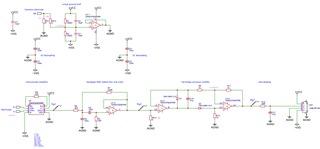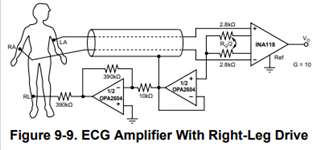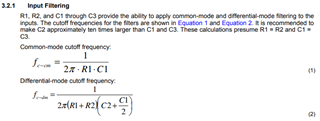- Ask a related questionWhat is a related question?A related question is a question created from another question. When the related question is created, it will be automatically linked to the original question.
This thread has been locked.
If you have a related question, please click the "Ask a related question" button in the top right corner. The newly created question will be automatically linked to this question.
Hello
I am designing EMG amplifier with INA333 and OPA4376. I use 3 dry electrodes made of stainless steel. I saw many designs and read a lot, but after making a prototype it wasn't working. If there is anyone with experience with EMGs it would be very valuable if could answer some of my questions.
1. I couldn't get any signal from first stage of amplifier - after INA333. I tried Rg values from 300R to 4,7k Ohms. I saw 2 different designs than most. One with 47uF capacitor in place of Rg (no resistor) and another with 300Ohm + 22uF in series in Rg. I couldn't find any explanation to it in datasheets or any other designs. Do you know purpose of it? Is there any article explaining using a capacitor in place of Rg resistor or adding capacitor in series to Rg? Should I care more about input bias? Any equation for choosing capacitor and resistor for proper gain?
A: 47uF https://hackaday.io/project/8823-super-simple-muscle-emg-sensor

"The super simple EMG circuit uses a capacitors reactive impedance attached to the IA gain pins, which sets a variable frequency dependant gain, thereby only amplifying higher frequencies, and thus creating a similar affect to a high pass filter. The capacitors impedance (which is inversely proportional to the IA amplification) is calculated from below equation
Impedance = 1/(2 ∗ PI ∗ Frequncy ∗ Capactance)"
B: 300R + 22uF https://www.dfrobot.com/product-1661.html
When I tried 300R + 10uF it worked! But I don't know why and if it is correct way to design. There is not enough explanation around on the Internet and many designs just use a resistor in Rg (no idea if these designs were checked in real).
2. Is voltage divider with buffer a good solution to supply power to INA and OPA? I saw that I have like ~200kHz noise on Vref and it brings noise to signal output. Any solution to this noise? When I removed OPA and used only divider without buffer then noise was gone, but divider without buffer is generally not a good idea.
I know that opams don't like high capacitance on output, but does it apply to buffered divider? I have to use decoupling capacitors on INA and OPA supply so it will add capacitance to buffer. Seems like no one cares about output capacitance when using opamp as a buffer to get virtual ground. Can input capacitance (two 10uF) influence working of the buffer?
Maybe I should change to low noise negative voltage generator?
Hi Artur,
the datasheet of INA118 shows a suited circuit.
A word on safety: Do only connect a circuit to your body which is battery powered and has no (NO!) connection to mains voltage or a mains voltage powered device !!!!!!!!!!
Kai
Hi Artur,
Please take Kai's advise and make sure that you are not getting hurt by experimenting with the apparatus. Use a single cell Li+ battery (up to 4.2Vdc) or 3 dry cell batter (up to 4.5V - 4.68Vdc) to power INA333 instrumentation amplifier.
1. I couldn't get any signal from first stage of amplifier - after INA333. I tried Rg values from 300R to 4,7k Ohms.
With 300Ω - 4.7kΩ, you should get an output signal from INA333. Here may be the possible reasons.
1. Your sensing signal may not have large enough surface area when contacting to a skin/muscle interface.
2. You may not use ionic conductive gel to increase the skin surface's conductivity.
3. You did not configure INA333 correctly without Vref voltage, as shown in the schematic below.

Below is the input Vcm and Vout linear relationship. For optimum input signals, the differential input signals need to be configured near Vcc/2 or approx. 2Vcm in this case. Configure Vref properly will determine the input Vcm and Vout linear operating ranges.

You may download the application GUI in the following link.
https://www.ti.com/tool/ANALOG-ENGINEER-CALC
EMG application should be very similar to EKG measurement technique. There is Vcm noise of AC source (50/60Hz AC noise) on the human body when it is measured indoors. You need to filter out or subtract the noise out in order to make a good S/N measurement, see the image and link below.

The above schematic can be found on p.30 of INA826's datasheet. The following block diagram what Kai refers to in INA118's datasheet.

When I tried 300R + 10uF it worked!
With 300R and 10uF, you have a variable gain in the INA333's analog front end. Assume AC frequency = 50Hz, the Rg is approx. 300Ω + 1/(2*pi*50*10uF) = 618 Ω. This also mean that INA333's gain should be in the approx. 163 V/V range. You will still add Vref, say 1.25Vref or 2.5Vref in order to get the circuit work properly. If you do not care about the gain of INA333's circuit, this approach may work for the specific AC source frequency.
2. Is voltage divider with buffer a good solution to supply power to INA and OPA? I
yes, for instance, you may use OPA333 to generate 1.25Vref or 2.5Vref. OPA376 is a good and low noise op amp for the application as well. If the apparatus is operating in battery, then you need to consider the quiescent and operating currents, so that the apparatus will work for longer period of time.

Let us get the INA333's analog front end stage working first. If you have additional questions, please let us know.
Best,
Raymond